



Introducing for facility of Momotaro-koi farm. Showing it by Video!! |



Bred with special quality parent for producing special grade koi from over
12million fries. |



Selling our own product which using it to our special koi. |



about us. |



Please take a look when you visit us by yourself. |



Please read it before shopping by internet. |



Please contact to our Agent and dealers in your country. |



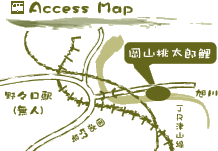

@
|
 |
  |
 |
|
 |
| 29th Jan 2008 |
From Nisai to Koi Show: A Look at 4 Momotaro Koi
The koi show is both an exhibition and a classroom. Hobbyists, dealers, and breeders prepare their koi for months, even years, to bring out the best of their koisf potential, then haul these koi, sometimes long distances, to be evaluated and compared with the competing koi. Koi students on all levels, professional or amateur, can use the koi show to learn about the characteristics of koi varieties, characteristics of different breeders, and even koi keeping skills.
One limitation of the koi show, however, is time. Both the koi and the viewer are what they are for that time only. Every koi at a koi show takes a path to get there, as does every koi viewer. A 50cm two year old koi soon becomes a 60cm three year old, sumi comes and goes, kiwa changes, koi peak. The viewer, or student, also changes. One year the difference between Sanke and Showa are mastered, the next year sashi and kiwa start to make sense, and later quality and growth potential are the main interests when observing and choosing koi. At a koi show, both the koi and viewers are points in a change.
As koi enthusiasts, a deeper understanding of how a great show koi becomes a great show koi should be of interest. How did this koi look as a nisai? What did the sumi on this Sanke look like last year? Questions like these go unanswered as we stand at the koi show vats on Saturday afternoons. With a look at the records of a koifs evolution, we can see that the best koi at the best koi shows around the world start with quality.
|
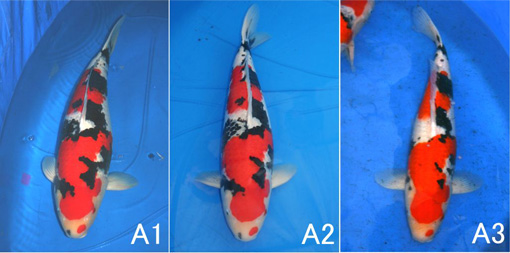
|
Almost anyone at the 2007 All Japan ZNA Koi Show in Ojiya, saw this stunning Sanke (A1). But how did it get to this point? Was the sumi always so bold? Was there more sumi that has condensed and went away?
This Sanke was born in 2004 and raised in concrete ponds from nisai until present. As a 50cm nisai(A3) this koi showed signs of heavy sumi, but the overall quality of all three colors was outstanding. From nisai to sansai this koi grew 13cm to become 63cm as seen in A2. By sansai the sumi has collected into bigger blocks that frame the first step of the hi-plate and add interest to the back half of the fish. Finally, in the autumn of 2007 at the ZNA show we can see the full maturation of the sumi as it contrasts with the white and red ground. Now a 70cm yonsai(4 year old), this fish is a standout even at Japanese National Koi Shows.
|
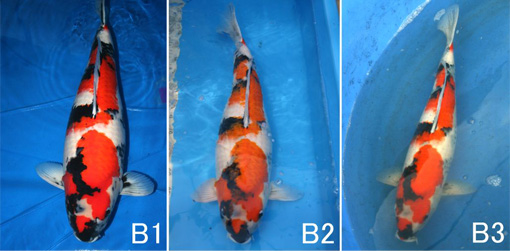 |
Not all koi change so drastically in pattern. A Momotaro 80cm gosai(5 year old) Showa won second in 80cm Showa Class at the 2007 ZNA National Show. As a 58cm nisai(B3) the koi looks like a lighter, smaller version of the same koi. The fish has even light colored beni with an attractive, undeveloped sumi pattern. All the potential for a great fish is present at nisai, yet few koi advance predictably from here. If every nisai kept the same quality and pattern until it become 80cm, there would be many of these fish at koi shows around the world. For a koi to maintain its assent in quality and beauty from nisai to sansai and then sansai to yonsai is rare. As a 68cm sansai(B2) we can see the pattern and colors of this fish remain unchanged. The body has matured and shows hints of what is to come. In the autumn of 2007 we can see the sumi on the right side of the koi has emerged to add balance and interest to the right side of the fish(B1). With a full body, an attractive pattern, and high quality, this koi can compete for top awards in the future.
|
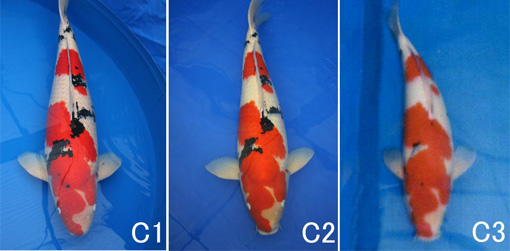 |
Another interesting Momotaro koi seen at this yearfs ZNA All Japan Show gives us a look at the slow changes of jumbo Sanke. As a 98cm nanasai(7 year old) Sanke, this Ryu-bloodline Sanke is at the top of the top class of Show koi in Japan(C1). Few koi reach this size and even fewer do so while retaining the beauty of this koi. As a 59cm nisai this koi was of high quality, average size, and unique undeveloped pattern. The hints of tsubo sumi on the left shoulder and right side base of the dorsal are just apparent in this picture taken soon after the fall harvest(C3). Three years later, after spending one season in the 1500 ton pond, the underlying sumi has come up to make this koi dynamic(C2). We can see much of the tsubo sumi has surfaced making this simple two-step Sanke a very interesting fish. By the autumn of 2007, after spending two more years in concrete ponds, the sumi has stabilized while the body added volume to the lengthy frame. Notice that in the nisai and nanasai pictures there is small sumi behind the head, yet at 5 years old there was none. Even though this koifs pattern was not a standout as a nisai, it had the right bloodline and was of the highest quality. When kept well, these koi have great potential.
|
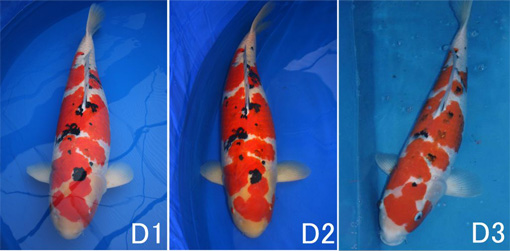 |
Lastly, a look at the progression of Momotarofs 105 cm Sanke. This koi was an offspring of Mako, Momotaro Koi Farmfs main Sanke oya, that was only 55cm as a nisai(D3). As a nisai this koifs shiroji and hiban are top class as it is the slender but strong body. At that stage, the sumi was a gamble. After 3 years in mudponds and a few years in the 1500 ton pond this koi had reached 97cm while maintaining one of the best bodies(D2). The sumi has surfaced in many of the white areas while receeding in the red areas. At this point, the beni and body are still the the best of the best. Finally, this autumn, at 105cm, this Sanke won Reserve Grand Champion at the ZNA All Japan Koi Show(D1). While not the best-patterned fish, this koi has come a long way from its days as a 55cm nisai.
Not all jumbo koi start as jumbo, and few show koi start their journey to their peak beauty as attractive as they look on show day in the show pools years later. Koi change, koi grow; this is why they will continue to interest koi keepers, dealers, and breeders around the world. Koi change, koi grow; this is why they should be studied. Highest quality koi from good bloodlines, kept in the best conditions can surprise even the most experienced koi students.
|
|
|
|
|

